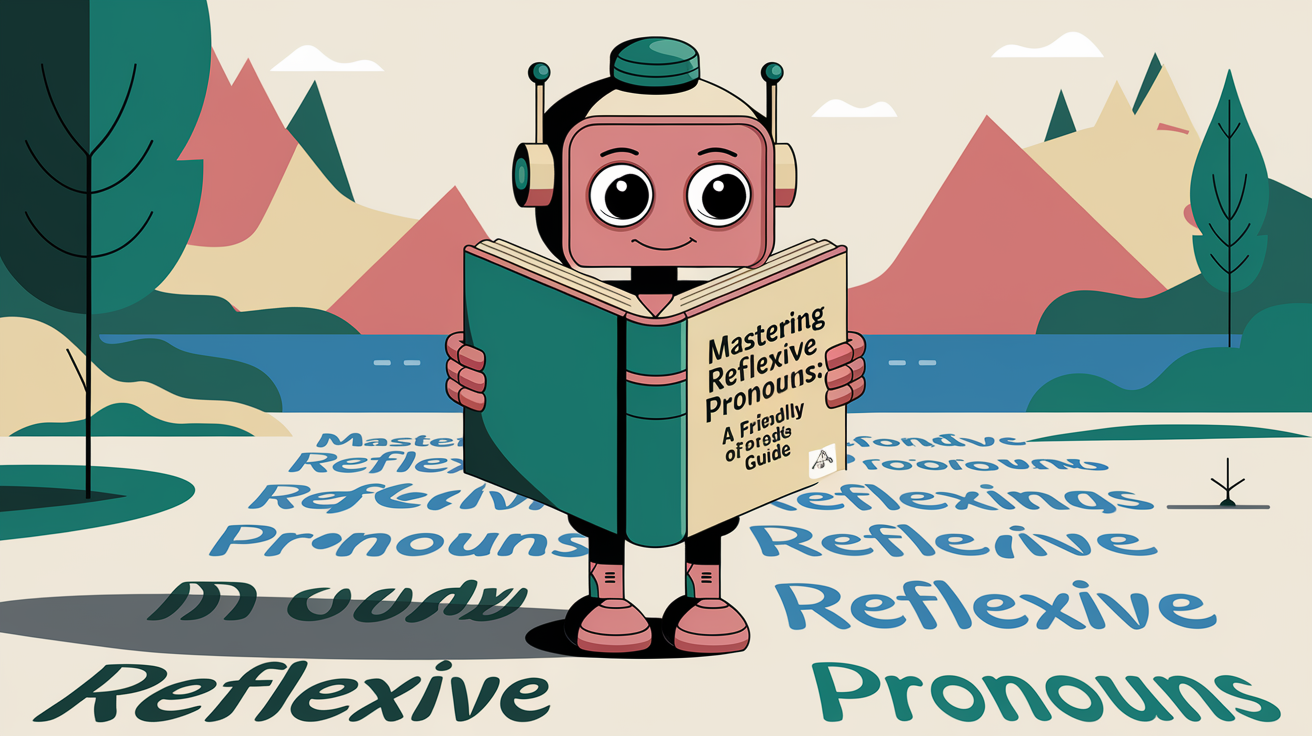Do you ever struggle with using reflexive pronouns correctly? You’re not alone. Words like “myself,” “yourself,” and “themselves” are key in English. Yet, they can confuse even the most skilled speakers and writers.
This guide aims to clear up the confusion around reflexive pronouns. It will help you use them with confidence and ease.

Key Takeaways
- Reflexive pronouns are an essential part of speech that help us refer to the subject of a sentence as the object of the same action.
- There are several types of reflexive pronouns, including “myself,” “yourself,” and “themselves,” each with their own specific usage and function.
- Mastering the placement and usage of reflexive pronouns can greatly improve the clarity and effectiveness of your written and spoken communication.
- Understanding the difference between reflexive and intensive pronouns is key to using them correctly.
- Reflexive pronouns can be used in a variety of grammatical constructions, including commands, infinitives, and gerunds.
Understanding Reflexive Pronouns
Reflexive pronouns are special because they point back to the person or thing in the sentence. They are made by adding “-self” or “-selves” to words like “I,” “you,” and “they.” Knowing how to use reflexive pronouns is key to good English.
What are Reflexive Pronouns?
Examples of reflexive pronouns are myself, yourself, and themselves. They are used when the subject and object are the same. For instance, “I cut myself” or “They bought themselves a new car.” They make sentences clearer by showing the connection between the subject and object.
The Role of Reflexive Pronouns
Reflexive pronouns have two main roles in English:
- To show that the subject and object are the same. For example, “She bought herself a new dress.”
- To highlight the subject of the sentence. For example, “The CEO herself attended the meeting.”
Understanding reflexive pronouns is vital for mastering English pronouns. They are a key part of the language.

“The correct use of reflexive pronouns is a common challenge for developing writers, but mastering their application can greatly improve the clarity and precision of one’s writing.”
Reflexive Pronouns in Everyday Language
Personal Pronouns and Reflexive Forms
Reflexive pronouns are key in our daily talk. They help us show actions done by ourselves and highlight the main person in a sentence. The six main pronouns – I, you, he, she, it, and they – have their own reflexive versions: myself, yourself, himself, herself, itself, and themselves. Knowing how these reflexive forms connect to their personal pronouns is crucial for clear speech.
In everyday chats, we often use reflexive pronouns without thinking. For instance, saying “I made the decision myself” or “They bought the tickets themselves.” These words make it clear who did the action.
But, using reflexive pronouns wrong is a common error, especially at work. Saying “Join these awesome engineers and myself for a discussion” is wrong. Instead, say “Join these awesome engineers and me for a discussion.” Learning to use reflexive pronouns right helps improve your English skills.
| Personal Pronoun | Reflexive Pronoun |
|---|---|
| I | myself |
| you | yourself |
| he | himself |
| she | herself |
| it | itself |
| they | themselves |
Understanding the link between personal pronouns and their reflexive forms boosts your ability to speak clearly. This is true in many everyday situations.

Using Reflexive Pronouns Correctly
Learning to use reflexive pronouns right is key to writing clear English. These pronouns show that the doer and receiver of an action are the same person. For example, “I washed the car myself,” or “She does chores herself.”
Sentence Structure and Placement
Usually, the reflexive pronoun goes before the verb, after the subject. But, there are times like in commands or with infinitives where it goes at the end. Getting the reflexive pronouns in the right spot is vital for sounding natural.
Commands and Infinitive Forms
- In commands, the reflexive pronoun comes after the verb: “Wash yourself before dinner.”
- With infinitive verb forms, the reflexive pronoun also follows the verb: “I want to enjoy myself at the party.”
Knowing how to use reflexive pronouns is crucial for writing correct and natural English. By getting the placement right, you can share your ideas clearly and with style.
| Sentence | Reflexive Pronoun Placement |
|---|---|
| I washed the car myself. | Before the conjugated verb |
| Wash yourself before dinner. | After the command verb |
| I want to enjoy myself at the party. | After the infinitive verb |
“Using reflexive pronouns correctly is crucial for conveying your message with clarity and sophistication.”
Categories of Reflexive Verbs
In Spanish grammar, reflexive verbs are special. They need a reflexive pronoun to show the subject and object are the same. Some verbs can be used both ways, but others only have a reflexive form.
Verbs That Exist Only in Reflexive Form
Some Spanish verbs, like aburrirse (to get bored), acordarse (to remember), and divertirse (to have fun), only have a reflexive form. They don’t have a non-reflexive version. The reflexive pronoun is key to their meaning and use.
For example:
- Me aburro (I get bored)
- Se acuerda (He/She remembers)
- Nos divertimos (We have fun)
| Reflexive Verb | Meaning |
|---|---|
| aburrirse | to get bored |
| acordarse | to remember |
| divertirse | to have fun |
| quejarse | to complain |
| arrepentirse | to regret |
Knowing the different types of reflexive verbs is crucial. It helps you use reflexive pronouns correctly in Spanish.
How to Use Reflexive Pronouns
To use reflexive pronouns right, follow this formula: subject + reflexive pronoun + verb. The reflexive pronoun must match the subject. It usually goes before the verb. But, there are times like commands or infinitives where it changes.
Practicing how to use reflexive pronouns is important. It helps you use them correctly in speaking and writing.
Reflexive pronouns include myself, yourself, himself, herself, itself, ourselves, yourselves, and themselves. They are used when the subject and object are the same. For example, “I bought myself a new shirt” or “The cat hid itself under the bed.”
- The reflexive pronoun formula is: subject + reflexive pronoun + conjugated verb.
- The reflexive pronoun conjugation must match the subject of the sentence.
- The placement of reflexive pronouns is typically before the conjugated verb, but there are exceptions, such as in commands and with infinitive forms.
| Subject Pronoun | Reflexive Pronoun |
|---|---|
| I | myself |
| You (singular) | yourself |
| He | himself |
| She | herself |
| It | itself |
| We | ourselves |
| You (plural) | yourselves |
| They | themselves |
Getting good at using reflexive pronouns takes practice. But, knowing the formula and how to conjugate them will help you use them well in your speech and writing.
Reflexive Verbs and Emotions
Reflexive verbs are key in Spanish for showing emotions. Words like alegrarse (to be happy) and asustarse (to get scared) show the subject feels something inside. Knowing how to use these verbs helps express feelings clearly.
Verbs for emotions include aburrirse, alegrarse, and asustarse. They always show what the subject feels inside. This makes them special in Spanish.
When two people do something together, we use nos, os, and se. To tell if it’s reflexive or not, we add words like el uno al otro. This helps us understand the action better.
| Reciprocal Verbs | Example Sentences |
|---|---|
| abrazarse | Los amigos se abrazaron con entusiasmo. |
| ayudarse | Los estudiantes se ayudaron durante el examen. |
| besarse | La pareja se besó apasionadamente. |
| casarse | Ellos se casaron el año pasado. |
| conocerse | Nos conocimos en una fiesta. |
Learning reflexive verbs is vital for Spanish skills. They help us share our feelings and stories deeply. By mastering these verbs, we can express ourselves better.
Non-Reflexive vs. Reflexive Verbs
In Spanish, some verbs can be used in two ways. They can be used without a reflexive pronoun or with one. Adding a reflexive pronoun can change the verb’s meaning. It’s important to know the difference to communicate well.
Verbs with Changing Meanings
For example, “bañar” means “to bathe someone” without a reflexive pronoun. But with “se,” it becomes “bañarse,” meaning “to take a bath.” This shows how reflexive verbs can mean something different than their non-reflexive form.
Other verbs also change meaning with reflexive pronouns:
- Levantar (to lift) vs. levantarse (to get up)
- Casar (to marry someone) vs. casarse (to get married)
- Sentar (to seat someone) vs. sentarse (to sit down)
Learning the difference between non-reflexive and reflexive verbs helps improve Spanish skills. It makes communication more effective.
“The position of reflexive pronouns in Spanish can vary depending on the tense or form of the verb; they can go before the verb, after the verb, or both in certain circumstances.”
Understanding non-reflexive and reflexive verbs is key to mastering Spanish. Recognizing these differences helps speakers communicate more clearly and precisely.
Emphasizing Actions with Reflexive Pronouns
In English, reflexive pronouns like myself, yourself, himself, herself, oneself, itself, ourselves, yourselves, and themselves are key. They show the subject’s role in an action. These pronouns, or “intensive pronouns,” don’t mean the action is done to oneself. Instead, they stress the subject’s personal involvement.
It’s important to know the difference between reflexive and intensive pronouns. Reflexive pronouns are used when the subject and object are the same. Intensive pronouns, on the other hand, emphasize the subject without changing the sentence’s meaning. This knowledge helps you use reflexive pronouns correctly.
For example, “She made the dress herself” shows she did it herself. It’s not about someone else making it. But “She herself made the dress” uses an intensive pronoun. It highlights her direct role in making the dress.
Getting good at using reflexive pronouns can make your writing and speaking clearer. By understanding the difference between reflexive and intensive pronouns, you can share your ideas more effectively. This engages your audience and makes your message stronger.
Whether you’re a native English speaker or learning it, knowing reflexive pronouns is important. They help you express yourself better. By using them wisely, you can make a bigger impact on your audience.
Impersonal Reflexive Structures
In Spanish, the pronoun “se” is key for those aiming to speak fluently and accurately. It can act as a reflexive pronoun or an impersonal structure. This makes it versatile and important for clear communication.
Impersonal reflexive structures focus on the action, not who does it. They use “se” without a specific subject. This way, information or instructions can be given without naming a person.
One way “se” is used is with a third-person singular verb. This makes the sentence sound like it’s in the passive voice. For example, “Se vende el coche” means the car is being sold, not who is selling it.
Another use is in “hay que + infinitive,” which shows something must be done. It uses “haber” in the third-person singular. This structure implies a general need without pointing to a specific person. For instance, “Hay que limpiar la casa” means the house needs to be cleaned, without saying who should do it.
Mastering these impersonal reflexive structures helps in communicating effectively. It allows for more detailed and general expressions in Spanish.
| Impersonal Reflexive Structure | Example | Explanation |
|---|---|---|
| “Se” + 3rd person verb | “Se vende el coche.” | The focus is on the action (selling) rather than the subject (the person selling). |
| “Hay que + infinitive” | “Hay que limpiar la casa.” | Expresses obligation or necessity without specifying the subject. |
“In Spanish, impersonal sentence structures are commonly used to communicate that something must be done without attributing it to a specific actor.”
Conclusion
In this guide, we’ve covered the key points about reflexive pronouns in English. We’ve looked at what they are, how they work, and when to use them. Learning about reflexive pronouns helps make your writing and speaking clearer and more expressive.
By practicing what you’ve learned here and looking for more resources, you can get better at English. This will make you more confident and skilled in talking and writing. The guide has given you a summary, explained why reflexive pronouns are important, and listed resources for more practice.
Using reflexive pronouns well is key to clear communication and showing you know English well. By using the tips and strategies from this guide, you can improve your speaking and writing. You’ll feel more confident and able to handle reflexive pronouns with ease.
FAQ
What are reflexive pronouns?
Reflexive pronouns point back to the sentence’s subject. They are made by adding “-self” or “-selves” to words like “I,” “you,” and “he.” This includes “we” and “they” too.
What are the main functions of reflexive pronouns?
Reflexive pronouns have two main roles. They show that the subject and object are the same. They also highlight the subject of the sentence.
How do reflexive pronouns relate to personal pronouns?
Personal pronouns like “I” and “you” have reflexive forms. These are “myself” and “yourself.” They help us communicate clearly and precisely.
What is the typical sentence structure for using reflexive pronouns?
The usual way to use reflexive pronouns is: subject + reflexive pronoun + verb. But, there are times like commands or infinitive verbs where the placement changes.
What are reflexive verbs, and how do they differ from non-reflexive verbs?
Reflexive verbs need a reflexive pronoun to show the subject and object are the same. Some verbs can be used both ways, changing their meaning with the reflexive pronoun.
How can reflexive pronouns be used to express emotions?
Some reflexive verbs show emotions like “alegrarse” (to be happy) and “asustarse” (to get scared). These verbs show the subject feels the emotion themselves.
What is the difference between reflexive and intensive pronouns?
Reflexive pronouns can also emphasize the subject, known as intensive pronouns. Here, they don’t show self-directed action but highlight the subject’s role in the action.
How can reflexive pronouns be used in an impersonal or generic way?
Sometimes, “se” is used without a specific subject. This is when the focus is on the action, not the person doing it.
